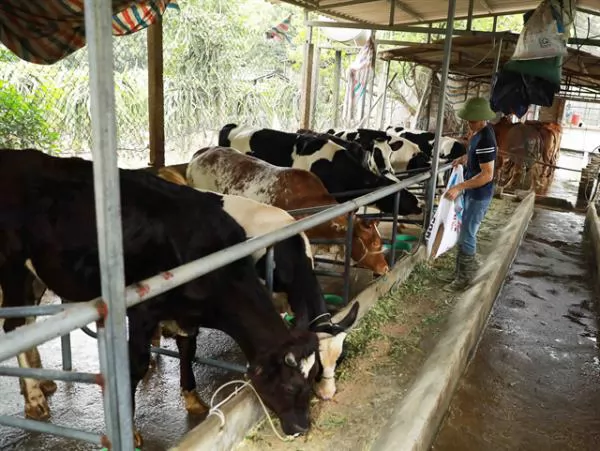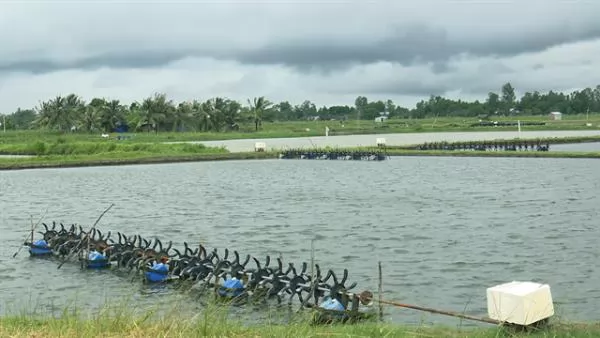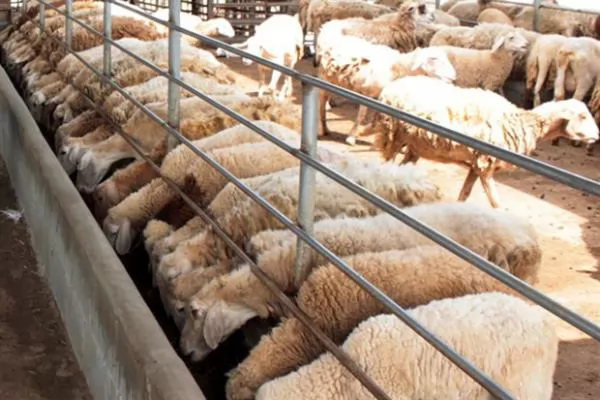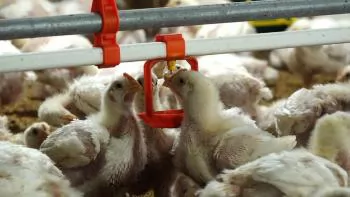Hà Nội cow farming sees room for development

A cow farm in Thuỵ An Commune, Ba Vì District, Hà Nội. — VNA/VNS Photo Vũ Sinh
Tố Như
HÀ NỘI — Cow farming in Hà Nội has great opportunities for development, said the director of the city’s Animal Husbandry and Veterinary Sub-Department Nguyễn Ngọc Sơn.
In the last few years, when pig and chicken farming were greatly affected by diseases, cow farming was considered a strategic solution for the city to realise the goals of restructuring the agricultural industry, increasing income for farmers, and gradually meeting the demand for beef, and cow milk in the city, he said.
According to the Hà Nội Department of Agriculture and Rural Development, the total cow population in the city is 130,000 heads, a decrease of 6.9 per cent compared with 2008 but productivity has increased by 36 per cent.
More than 13,800 cows are raised for milk while 117,000 cows are raised for beef and other products. Every year, Hà Nội supplies the market with about 8,000 dairy calves and 55,000 meat calves.
It is estimated that the city's demand for meat and poultry is about 320,000 tonnes per year or nearly 900 tonnes per day. Meanwhile, the city's livestock production only meets about 60 per cent, the rest must be imported from the provinces and countries.
As for beef products, the city's production output is more than 10,000 tonnes per year, only meeting nearly 20 per cent of the beef demand. The output of fresh cow's milk reached 38,600 tonnes, only meeting nearly 30 per cent of the consumption demand of the people in the capital city.
As one of the households supported by the Hà Nội Agricultural Development Center to raise high-yield cows, Nguyễn Bá Anh, a farmer in Zone 5, Minh Châu Commune, Ba Vì District, said that he was continuously supported to raise high-yielding cows and apply intensive farming to increase productivity for commodity production.
“The switch to raising high-yielding cattle breeds is much more efficient than traditional grass cows,” he said.
In the past, traditional cow farming generated a profit of VNĐ5 - 6 million per year. Now, a high-yielding cow helps him earn VNĐ8-10 million per year.
“Currently, my family is raising 28 cows, including four Wagyu cows. Thanks to the development of high-quality cow breeding, my family has a yearly income of VNĐ250-300 million,” he said.
Director of Ba Vì Green Farm and Cow Development Co-operative Tạ Viết Hùng said that producing dairy cows with sex-segregated dairy cow semen was appreciated by many breeders because of its advantages.
Calves born from sex-segregated dairy cow semen have a good appearance, good growth and development, and are characterised by breed quality. The ability to gain weight of the calves is about 1 kg per day. At the mature stage, cows have high yield and high-quality milk, Hùng said.
Deputy Director of Hà Nội Department of Agriculture and Rural Development Tạ Văn Tường said that Hà Nội People's Committee had recently approved a plan to improve the quality of beef and dairy cow breeds between 2021 and 2025.
Under the plan, the agricultural sector will promote the application of high technology in animal breeds, animal feed, breeding conditions and veterinary hygiene.
Models that promote the linkage among animal husbandry, slaughter, processing and consumption will be expanded.
Closed production and value chains are encouraged to help reduce production costs, increase efficiency and add value.
Trade promotion for the city’s livestock products is needed, Tường said, adding that the city’s agriculture department would closely coordinate with other localities, especially the 10 provinces of the Red River Delta, in the supply and consumption of farm produce.
The city will also strengthen inspecting livestock production facilities, preliminary processing and product processing establishments.
Disease surveillance will be given more attention so that diseases can be prevented early, detected and handled in time to curb infections and minimise damage. — VNS
Maybe you are interested

Sóc Trăng develops effective shrimp farming models
SÓC TRĂNG — Farmers in the Cửu Long (Mekong) Delta province of Sóc Trăng have begun breeding shrimp, and hope for a yield of 196,000 tonnes this year, according to the local Fisheries Sub-department.

Ninh Thuan to breed more sheep, goats for sale
The south-central province of Ninh Thuan, the country's largest animal producer, is strengthening measures to breed more sheep, goats, pigs and other animals for commercial production.

Digital livestock farming in Thai Nguyen: From policy to practical action
Thai Nguyen is methodically implementing digital transformation in the livestock sector, laying the foundation for a modern, transparent, and sustainable agriculture.





